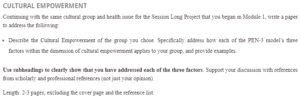Cultural Empowerment-PEN-3 Model in Drug and Alcohol Abuse Among Youth
The PEN-3 cultural model focuses on culture in studying health outcomes, behaviors, and beliefs. The model also centralizes culture in developing, implementing, and evaluating public health interventions. Its focus is on the role that culture plays in connecting the individual actions and perceptions regarding health, shapes and defines health while acknowledging that these are the building blocks in health beliefs’ construction that are then reproduced to express the individual’s cultural beliefs. Additionally, the PEN-3 model offers a frame for organizing and centralizing culture when framing and defining solutions and health problems, respectively. Further, these solutions are such that they reward and encourage positive values that are sustained in a better way as opposed to focusing on the negative values only.
There are three primary domains in the PEN-3 model, and these are the Cultural Identity domain, Relationships and Expectations, and the Cultural Empowerment domain. Within the Cultural Empowerment domain, there are three categories, namely positive, existential, and negative.
Positive
This refers to the beliefs and practices that are positive. Solutions beneficial to health problems are preferred and encouraged in this domain. In the context of alcohol and drug abuse, positive solutions need to be identified and encouraged. Prevention of drug and alcohol abuse is a positive solution to the menace among the youth. According to Kuntsche and Kuntsche (2016), parents and guardians play a pivotal role in positively impacting their children and preventing them from becoming alcohol and drug users. To accomplish this, parents can show affection and love to the child as it grows; have fair and consistent discipline; open communication channels for feelings and thoughts; create opportunities for successful experiences at school and home; create a stable family atmosphere; tolerate child mistakes without put-downs; become models of strong, feeling, and thoughtful adults; and give their children accurate information about the problems they are likely to face when growing up such as crimes, drugs, sexuality, among others.
Existential
This domain explores the values and beliefs that are existential and have no harmful health consequences. The health of a person is influenced by social connections and networks. Individuals with high community cohesion and social support levels tend to be healthier because of their better links with medical costs, financial support; better health services access; and basic health information (Sudhinaraset, Wigglesworth, & Takeuchi 2016).
Regarding alcohol and drug abuse among the youth, individuals are nested within the microsystem of their school work and home, which is also nested within community use (Sudhinaraset, Wigglesworth, & Takeuchi 2016). The macro-level factors such as advertisement exposure can have an influence on the peer and family network norms and attitudes, which in turn affect the behaviors and attitudes of individuals. Further, ethnic identity may promote stronger traditional ties and family values that lead to lower consumption levels of alcohol. Also, when individuals live in neighborhoods that do not condone binge drinking, it is possible that such an individual has a lesser likelihood of drinking; and this is more so for women, thus suggestive of gender norms as a factor surrounding alcohol use (Sudhinaraset, Wigglesworth, & Takeuchi 2016).
Negative
The cultural beliefs and norms that are harmful and have negative health consequences also need to be identified when seeking solutions to alcohol and drug abuse among youth. When youth leave their home environment, enter college, and join a Greek association, they tend to become alcohol users because of the more socially permissive norms that surround drinking (Scott et al., 2008). Also, higher consumption levels among peers and parents are directly linked to increased use of alcohol among youth (Varvil et al., 2014; Walsh et al., 2014). The existing successful interventions on alcohol use reduction include the incorporation of delivery models that are culturally sensitive such as having community health workers working with Latinos (Ornelas et al. 2014) as well as the use of web-based interventions to alter the norms (Patrick et al. 2014).
References
Kuntsche, S., & Kuntsche, E. (2016). Parent-based interventions for preventing or reducing adolescent substance use—A systematic literature review. Clinical psychology review, 45, 89-101.
Ornelas, I. J., Allen, C., Vaughan, C., Williams, E. C., & Negi, N. (2015). Vida PURA: A cultural adaptation of screening and brief intervention to reduce unhealthy drinking among Latino day laborers. Substance abuse, 36(3), 264-271.
Patrick, M. E., Lee, C. M., & Neighbors, C. (2014). Web-based intervention to change perceived norms of college student alcohol use and sexual behavior on spring break. Addictive behaviors, 39(3), 600-606.
Scott-Sheldon, L. A., Carey, K. B., & Carey, M. P. (2008). Health behavior and college students: Does Greek affiliation matter?. Journal of Behavioral Medicine, 31(1), 61-70.
Sudhinaraset, M., Wigglesworth, C., & Takeuchi, D. T. (2016). Social and Cultural Contexts of Alcohol Use: Influences in a Social-Ecological Framework. Alcohol research: current reviews, 38(1), 35–45.
Varvil-Weld, L., Turrisi, R., Hospital, M. M., Mallett, K. A., & Bámaca-Colbert, M. Y. (2014). Maternal and peer influences on drinking among Latino college students. Addictive behaviors, 39(1), 246-252.
Walsh, S. D., Djalovski, A., Boniel-Nissim, M., & Harel-Fisch, Y. (2014). Parental, peer and school experiences as predictors of alcohol drinking among first and second generation immigrant adolescents in Israel. Drug and Alcohol Dependence, 138, 39-47.
ORDER A PLAGIARISM-FREE PAPER HERE
We’ll write everything from scratch
Question
CULTURAL EMPOWERMENT
Continuing with the same cultural group and health issue for the Session Long Project that you began in Module 1, write a paper to address the following:
- Describe the Cultural Empowerment of the group you chose. Specifically, address how each of the PEN-3 model’s three factors within the dimension of cultural empowerment applies to your group, and provide examples.
CULTURAL EMPOWERMENT
Use subheadings to clearly show that you have addressed each of the three factors. Support your discussion with references from scholarly and professional references (not just your opinion).
Length: 2-3 pages, excluding the cover page and the reference list.


